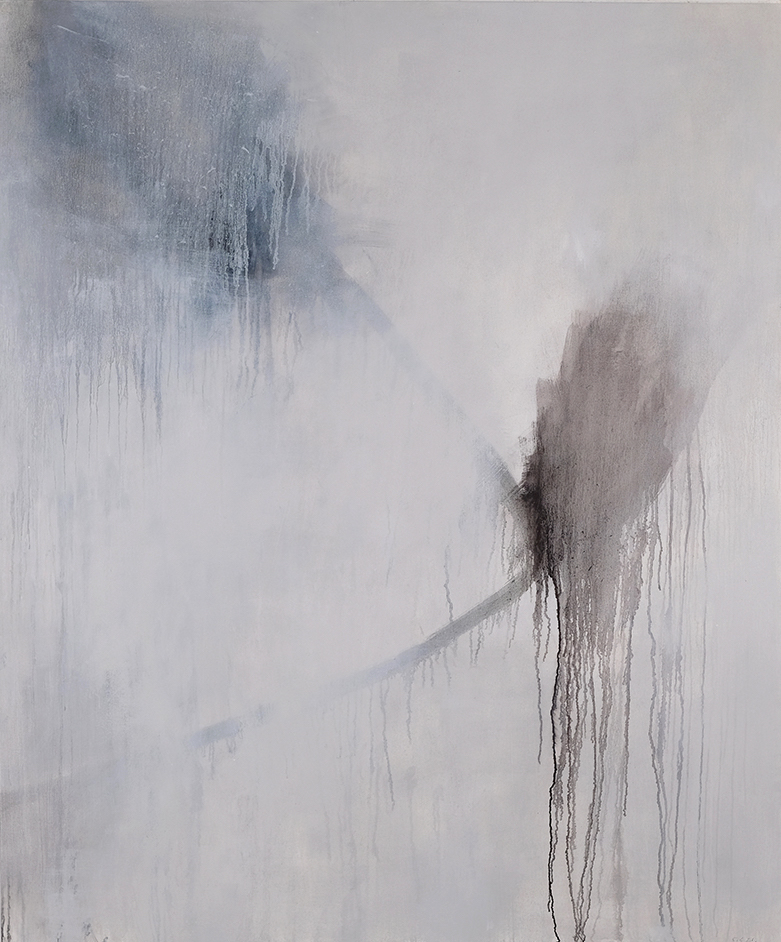
STEVEN SEINBERG: RECENT WORK
Essay by Peter Frank
When is a mark not a mark? When it is not merely a mark. What makes a mark more than a mark? A mark maker with broader cause, one who seeks to reach beyond the clatter of marks and make a language of and place for marks. Marks as space. Marks as notes. Marks as meanings. Marks as contexts. Marks as sensations. Marks as sounds. Marks as weather.
Steven Seinberg’s broader cause expands beyond his marks and at the same time plunges into his marking. For years Seinberg has experimented with medium and manner to determine the best ways of harnessing marks to their provocative potential. He has determined two distinct formulas for doing so. One provides picture, the other notation. One provides atmosphere, the other thought. Neither is a pure manifestation of marking; the marking process, certainly as presented in the austere reflexivity of post-minimalist practice, does not engage Seinberg. Rather, the resonance of his marking emerges from a lyrical, associative sensibility, one reliant on the poetic connection and sensual, even somatic frisson, characteristic of the gestural abstraction that predominated, in the United States and abroad, in the years after World War II. It would not be ambitious to regard Seinberg’s works on paper – collages especially – as a kind of quasi-visual verse, or his paintings as passages in the account of some epic quest.
Is Seinberg, then, striving to revive a mid-century sensibility? Do his fogs and fragments, his moody vistas and scrapbook composites, point us to any particular time and/or place and/or event? They can; but the evocations are in the eye and mind – and heart – of the beholder. If in fact Seinberg wishes to resuscitate the language of painterly abstraction, it’s the evocative aspect – the poetry of vision – that he wants to bring to the fore. What we behold are the elements of song and memory, dream and detail, ingredients for the imagination and at the same time discrete receptacles for it. The tone is one of ecstasy suffused throughout melancholy in the paintings, vice versa – contemplative retreat signaled by the play of assembly – in the collages. The marks variously rain on the eyes and lead them on treasure hunts, forming almost palpable fields of moisture in the paintings, or setting out documentation, at once familiar and arcane, in the work on paper.
Poetry and gesture thus power Seinberg’s work, binding it not to a previous era in art but to enduring qualities that we associate with pictorial conditions available throughout the history of painting (and not just in the West). Seinberg’s mists and drizzles, for instance, recall J.M.W. Turner’s; but there is a change in the weather between them. The 19th century Englishman wielded fog like a soft monster swallowing the world; the 21st century American employs it as a cleansing force, inhaling hexes and toxins and easing the soul’s stress, a kind of brush-applied mantra to becalm the soul. Note well, though; some of Seinberg’s magic-breath canvases offer more tranquility than others, and none ever devolves into optical anodyne. Indeed, key to their healing effect is the paintings’ reliance on a reticent palette expressed in a scumble of, yes, marks, gentle and alluring but not pretty. This is food, not clothing, for the retina.
Seinberg’s collages, as noted, serve a more or less complementary function to his paintings. The vocabulary of forms certainly overlaps, but it deploys to different effect in the work on paper than in their canvas counterparts. It is as easy to see the two bodies of work, at least recently, as that produced by two different hands as by one. This, of course, is to Seinberg’s credit; we have come to understand that artists are more than likely to work in more than one fashion at a time, that the breadth of their practice almost requires variety and relaxed (if not downright unbound) possibility. The underlying sensibility of the artist emerges nevertheless – allowing us to appreciate and unpack that sensibility that much further. Seinberg’s collages and his paintings share certain factors – rough silhouettes of plants, informal repeated mark-motifs – but involve them in markedly different visual experiences, ordered and composed very differently, scaled very differently, offering very different notions of texture and touche. Where the paintings offer enveloping respite, the collages present another kind of meditative release, resembling ancient, partly deciphered, partly undecipherable texts whose illuminations add to the mystery by becoming entangled in the calligraphy of the page.
The work Steven Seinberg has produced in the last couple of years has seen a certain refinement and focus of eloquence. We might attribute this to the relative isolation current events have forced upon him, as on the rest of us; but these moments of evolution and artistic growth have occurred in Seinberg’s studio before, so they are hardly unique to a pandemic. The heightened elegance and sensual coherence of the recent work mark a renewed clarity in the artist’s oeuvre, but that clarity is even more valuable and meaningful to us than it is to him: this kind and modest beauty is balm to our plague-wracked eyes. There’s more than a bit of truth to the conception of the artist as a shaman. Certainly, in these accretions of marks, these assemblies of strokes and lines and clusters and washes and elusive but potent images, Seinberg reaches out to us to share in the healing.
-Peter Frank
Los Angeles
2021